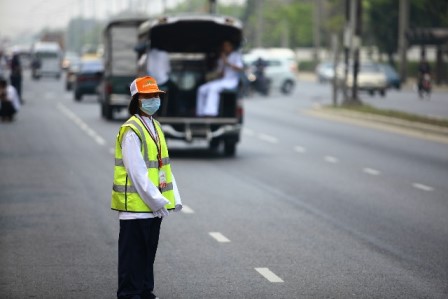You are here
Ongoing Research
At any given time, HEI has a variety of ongoing studies at various stages of completion. Here, you will find a list of studies with more detailed information for each, including abstracts and posters presented at HEI Annual Conferences. We also indicate which studies have been completed and are currently undergoing HEI’s rigorous review process.

Ongoing Studies
Accountability Studies
Studies funded under RFA 23-2, Assessing Changes in Exposures and Health Outcomes in Historically Marginalized and Environmentally Overburdened Communities from Air Quality Actions, Programs, or Other Interventions; RFA 18-1, Assessing Improved Air Quality and Health From National, Regional, and Local Air Quality Actions; and HEI’s Open and Rosenblith RFAs
Accountability Studies
Studies funded under RFA 23-2, Assessing Changes in Exposures and Health Outcomes in Historically Marginalized and Environmentally Overburdened Communities from Air Quality Actions, Programs, or Other Interventions; RFA 18-1, Assessing Improved Air Quality and Health From National, Regional, and Local Air Quality Actions; and HEI’s Open and Rosenblith RFAs
In this HEI-funded project, the investigators will build on their previous accountability analyses in Atlanta, New York, and Los Angeles to characterize the health impacts of MV and EGU policy implementation.
What? Identify the health and equity impacts of state and local zoning policies for minimizing traffic-related air pollution (TRAP) from commercial vehicle fleets and distribution centers serving residential delivery in the Seattle and New York City areas.
How? Develop scenarios and analyze the health effects and equity implications of future low- and zero-emission vehicle procurement programs, truck delivery efficiency improvements, and urban land use policies on logistics-related development. The project integrates stakeholder interviews, policy scans, traffic demand modeling, and simulation to estimate the health risks of chronic exposure to e-commerce-related TRAP in marginalized communities.
Where? Seattle and New York City.
This study will focus on a coal ban and heat pump subsidy program in the Beijing, China, region. They are building on an existing panel study that is following about 966 people who live in 50 villages around Beijing. Half the villages are subject to the policy, the other half are not.
What? Examine the air quality, health, and equity implications of adoption of US EPA Clean truck rule, Advanced Clean Trucks regulation, and vehicle omnibus regulation in Chicago and whether policy-driven air pollution changes in Chicago are transferable nationwide.
How? 1. Use new satellite data, along with other publicly available datasets, to improve the accuracy of nationwide heavy-duty vehicle emissions, with a focus on emissions from warehouse environments. 2. Use updated emissions estimates in a high-resolution chemical transport model to understand how warehousing-related emissions and emission reduction policies affect exposures, health, and equity.
Where: Chicago and Nationwide.
This study will evaluate the major national regulatory policies that were implemented in China from 2008–2018. The investigators will focus on regulations in particular regions that target specific sources, such as coal combustion, and how they have reduced ambient concentrations of fine particles (and their components).
What? Assess the effects of California’s Advanced Clean Trucks and Advanced Clean Fleets regulations on air pollutant exposure and health disparities in Southern California.
How? Estimate the impact of recently adopted zero-emission truck regulations changes on tailpipe and non-tailpipe pollutant emissions, refine an air quality model to simulate the corresponding changes in air pollutant concentrations, and assess disparities in exposures and health outcomes (mortality and asthma emergency department visits) in freight transport communities in Southern California.
Where: Southern California.
COVID-19, Air Pollution, and Health Studies
HEI funded five different COVID-19 studies under RFA 20-1B. Two of these studies have been published; see Research Report 214 (Andersen et al.) and Research Report 220 (Tonne et al.). Studies in progress or under review are listed below. This research is taking place in the United States, Europe, and Asia and it focuses on two key areas:
- Accountability studies: Evaluating how interventions to control the pandemic might have affected emissions, air pollution, and human health.
- Susceptibility studies: Evaluating how air pollution exposure might affect the COVID-19 disease course, and how race, ethnicity, and socioeconomic status might also play a role.
COVID-19, Air Pollution, and Health Studies
HEI funded five different COVID-19 studies under RFA 20-1B. Two of these studies have been published; see Research Report 214 (Andersen et al.) and Research Report 220 (Tonne et al.). Studies in progress or under review are listed below. This research is taking place in the United States, Europe, and Asia and it focuses on two key areas:
- Accountability studies: Evaluating how interventions to control the pandemic might have affected emissions, air pollution, and human health.
- Susceptibility studies: Evaluating how air pollution exposure might affect the COVID-19 disease course, and how race, ethnicity, and socioeconomic status might also play a role.
This study will investigate the chronic and acute effects of air pollution exposure on COVID-19 incidence, mortality, and long-term complications, including onset of disease formation. Long- (2017−2018) and short- (2020) term exposures will be linked to a large medical records database in Southern California, with assessments at both the neighborhood and individual level.
Enhanced Exposure Studies
Enhanced Exposure Studies
Hoek and colleagues will prepare maps of modeled annual average air pollution across the Netherlands, validate the maps using new measurements from over 100 sites, and evaluate the performance of several exposure models. The investigators will conduct cross-comparisons to evaluate how different exposure assessment methods compare in their ability to predict long-term pollutant concentrations, with a particular focus on spatial variability of pollutants.
This study will compare and contrast scientific and logistical benefits of different approaches to air pollution exposure assessment. The investigators will leverage large air pollution datasets obtained from low-cost sensors, mobile monitoring, and passive samplers. They will apply the exposure assessment approaches to determine associations with cognitive decline and dementia incidence in an ongoing cohort study, Adult Changes in Thought Air Pollution (ACT-AP).
Quantifying Real-World Impacts of Non-Tailpipe Particulate Matter Emissions
Quantifying Real-World Impacts of Non-Tailpipe Particulate Matter Emissions
This study will measure concentrations of non-tailpipe particulate matter across Toronto, Canada, to determine how much non-tailpipe pollution people might breathe in everyday life and how to better measure these exposures in the future.
In this study, participants with mild to moderate asthma will ride stationary bicycles on sidewalks in three London, UK environments (busy road characterized by stop-and-go traffic, high speed continuous traffic, and urban background) to measure how exposure to traffic with different mixtures of non-tailpipe and tailpipe emissions affects lung function of asthmatic adults.
Traffic Exposure and Health Studies
Studies funded under RFQ 24-1, Benefits Assessment of Accelerated Turnover of the On-Road Diesel Vehicle Fleet in the United States; RFA 23-1, Assessing Health Effects of Traffic-Related Air Pollution in a Changing Urban Transportation Landscape; and RFA 17-1, Assessing Adverse Health Effects of Exposure to Traffic-Related Air Pollution, Noise, and Their Interactions With Socio-Economic Status.
Traffic Exposure and Health Studies
Studies funded under RFQ 24-1, Benefits Assessment of Accelerated Turnover of the On-Road Diesel Vehicle Fleet in the United States; RFA 23-1, Assessing Health Effects of Traffic-Related Air Pollution in a Changing Urban Transportation Landscape; and RFA 17-1, Assessing Adverse Health Effects of Exposure to Traffic-Related Air Pollution, Noise, and Their Interactions With Socio-Economic Status.
This project will link and extend several models to create a framework for full-chain assessment of transportation systems and impacts of traffic-related air pollution (TRAP) on population health in the San Francisco Bay Area. The investigators will evaluate impacts of three policy scenarios — federal/California long-term transportation electrification, telecommuting impact from COVID-19, and a community-led scenario — on exposure to TRAP and associated mortality and morbidity outcomes, including environmental justice disparities.
In this study, the investigators will recruit pregnant women in Barcelona and assess the effects of in-utero exposure to traffic-related pollution on birth weight, fetal growth trajectories, and placental function for each pregnancy. The investigators will estimate exposure to several pollutants and transportation noise and evaluate the roles of socioeconomic status, green space, physical activity, diet, and stress.
This study will assess the effects of metals from nontailpipe emissions on asthma and lung function in the most recent cohort of the Children’s Health Study in Southern California (recruited during 2002-2012), using available filters with particulate matter samples. The investigators will estimate exposure to several pollutants and transportation noise and evaluate the roles of socioeconomic status, green space, physical activity, diet, and stress.
This project will leverage an existing randomized control trial of older individuals in the United States to examine the associations of exposure to traffic-related air pollution and incident cardiovascular disease events and biomarkers of cardiovascular health. The investigators will also explore the potential for vitamin D and omega-fatty acid supplementation to modify the associations.
This project will assess the impacts of future urban transportation landscapes on cardiometabolic health through novel exposure estimation together with air quality modeling of traffic-related air pollution (TRAP). Exposures will be associated with markers of cardiovascular diseases using an existing population-based cohort in Augsburg, Germany. Findings will be then scaled up to the whole study area population (Munich metropolitan area), and eventually all of Germany. Various transportation scenarios will be evaluated, such as those related to transport infrastructure, technological advancements, and pricing policies.
This project will develop models relevant for characterizing exposures from vehicle (tailpipe and non-tailpipe), rail, and aircraft sources and relate those exposures to birth outcome data in the Los Angeles area. They will also include a social vulnerability analysis and will assess the effect of electric vehicles, flight technologies, and the COVID-19 travel disruptions on air pollution and birth outcomes.
Wildland Fires and Agricultural Burning Studies
Wildland Fires and Agricultural Burning Studies
This study is investigating risk of birth outcomes and perinatal mortality from fire-related PM2.5. The interdisciplinary team is developing fire modeling methods to estimate PM2.5 specifically from fires for Australia with improved fire emissions inventories and Lagrangian modeling.
The objectives of this study are to: 1) Estimate the contributions of prescribed burning to both fine particulate matter (PM2.5) and ozone (O3) levels in the Southeastern US; 2) Quantify the effects of prescribed fire smoke on rates of emergency department (ED) visits; and 3) Assess how the observed health impacts vary across strata defined by age, sex, and socioeconomic markers.
Walter A. Rosenblith Award
This New Investigator Award study seeks to examine associations of long-term maternal exposures to PM2.5, NO2, and environmental noise with adverse birth outcomes in Accra, Ghana. The investigators also seek to determine the effect of these exposures on the risk of lower respiratory infections in infants.
The primary objective of this study, led by HEI's 2021 Walter A. Rosenblith New Investigator Award recipient Lucas Henneman, is to create fine-scale daily PM2.5 source impacts from major source and fuel categories from 2011-2020. This objective builds on recent work developing fine-scale daily air pollution exposure products in the United States, which have driven recent epidemiological studies on air pollution health effects.
Dr. Nethery’s study seeks to develop statistical methods for characterizing spatial and racial and ethnic variation in health effects associated with exposure to fine particulate matter (PM2.5) across the United States, and to design potential policies for reducing PM2.5-attributable health inequities.
Dr. Ornelas Van Horne’s study seeks to advance a community-academic partnership with Missouri Breaks Industries Research (an American Indian-owned research center serving Indigenous communities and others in North and South Dakota) and Columbia University to characterize sources of air pollution and identify community-driven solutions through an emissions reduction plan.


